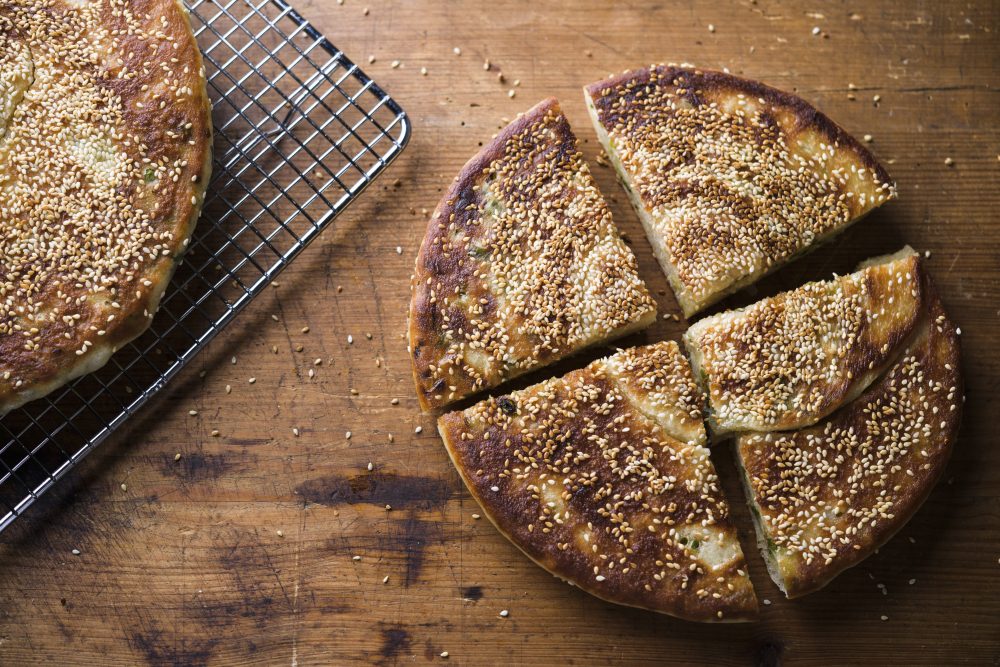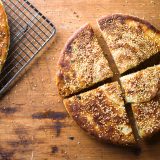Driving past Darda Seafood Restaurant—an unassuming eatery wedged into a bland suburban strip mall in Milpitas, California—you might not recognize it as a premier destination for an elusive bread.
But every weekend, crowds flock to Darda for a taste of its legendary Chinese Muslim fare. They come for the spicy lamb with cumin, the Mongolian Beef and the thick homemade noodles. But perhaps more than anything, they come for the sesame scallion bread, or zhima dabing.
Take a bite and the nutty crunch of its fried, sesame-coated exterior gives way to the soft chew of its scallion-studded interior, a balance of textures and flavors. A yeast-risen bread, it’s more reminiscent of focaccia than its far more ubiquitous culinary cousin, cong you bing, or scallion pancake.
It’s larger, too. Cooked in a skillet, zhima dabing—which literally translates to “sesame big pancake”—often is presented to diners as an immense sesame-lacquered slab. “Sometimes they’re the size of a car wheel!” says Carolyn Phillips, author of the cookbook “All Under Heaven: Recipes from the 35 Cuisines of China” (and an ardent Darda fan). Though it’s meant as a side, for many customers zhima dabing is the main event.
Though zhima dabing is a rare find on menus in the U.S., it’s quite common in northwestern China, as Naomi Duguid, co-author of “Beyond the Great Wall,” found during her travels to Xining.
In this bustling city on the Tibetan Plateau, roughly a sixth of the population is Hui Muslim (one of China’s many Muslim groups). Their presence reflects the millennia of cultural crossover at these ancient Silk Road trading outposts. When the weather is mild, Xining’s street food scene becomes especially lively. “At night people come out to eat and wander,” Duguid says. Here, amid stalls hawking grilled lamb skewers and hand-pulled noodles in steaming vats, you’ll find bread vendors rolling out and shaping zhima dabing. Such flatbreads—and not rice—traditionally serve as the main starch in Chinese Muslim cuisine, with the cooking of northern China being more wheat-based in general.

Back at milk street, we set out to recreate the zhima dabing we’d first tried in California. Our initial experiments seemed to reveal why this bread might be in short supply in the U.S. Time and again, our attempts ended in disappointment, producing loaves that were dense, doughy and sorely lacking that delightful chew. Turns out, we’d been overlooking something vital—the flour.
The standard flour used in China is different from American all-purpose, which is higher in protein (and thus higher in gluten) than most Asian flours. A lower-gluten flour is essential to achieving the telltale texture of zhima dabing: “You don’t get that toughness that you would get with an all-purpose flour,” says Phillips. She tames the toughness of all-purpose by blending it with low-protein flours.
At Milk Street, for that task we turned to sweet rice flour, also known as glutinous rice flour. Don’t let the name mislead you; this flour is entirely gluten-free. Made from milling sticky rice, it takes on a chewy texture when hydrated and baked. We found that adding ¼ cup sweet rice flour to 1⅔ cups all-purpose flour gave us the results we desired.
Once you get the flour right, the rest of the recipe comes together easily. Mix the ingredients, coat the dough with sesame oil, then let it rise. Shaping the dough involved flattening it, covering it with scallions, then rolling and coiling it into a round before flattening it again. It’s this technique, in fact, that leads to dabing occasionally being referred to as “coiled bread.”
Starting the sesame seed-covered dough in a cold skillet on the stovetop, and flipping just once, allows it time to cook through without getting too dark on the bottom.
“If you’re familiar with bread, then it’s a real snap,” Phillips says. And thankfully so—because, for most of us, the only way to satisfy a craving for zhima dabing is to make it yourself.




